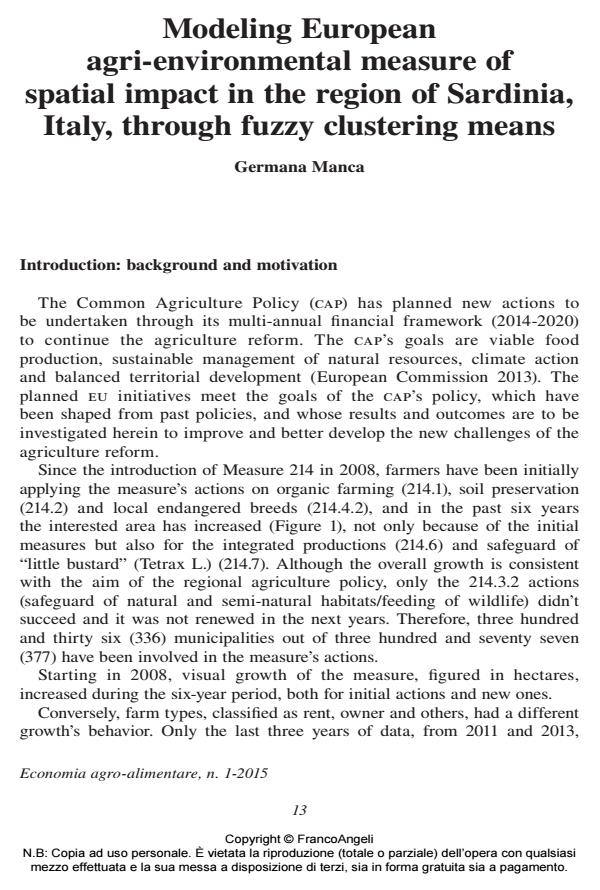Modeling European agri-environmental measure of spatial impact in the region of Sardinia, Italy, through fuzzy clustering means
Titolo Rivista ECONOMIA AGRO-ALIMENTARE
Autori/Curatori Germana Manca
Anno di pubblicazione 2015 Fascicolo 2015/1
Lingua Inglese Numero pagine 15 P. 13-27 Dimensione file 352 KB
DOI 10.3280/ECAG2015-001002
Il DOI è il codice a barre della proprietà intellettuale: per saperne di più
clicca qui
Qui sotto puoi vedere in anteprima la prima pagina di questo articolo.
Se questo articolo ti interessa, lo puoi acquistare (e scaricare in formato pdf) seguendo le facili indicazioni per acquistare il download credit. Acquista Download Credits per scaricare questo Articolo in formato PDF

FrancoAngeli è membro della Publishers International Linking Association, Inc (PILA)associazione indipendente e non profit per facilitare (attraverso i servizi tecnologici implementati da CrossRef.org) l’accesso degli studiosi ai contenuti digitali nelle pubblicazioni professionali e scientifiche
The aim of this paper is to demonstrate how a spatial fuzzy clustering mean expands the knowledge of the European agri-environmental initiative impact, named Measure 214, in the Sardinia Region. While sketching out the geographic area covered by the measure for analysis and investigation using fcm is a fruitful approach, their integration with social and economic factors is an essential step in understanding agricultural growth and how it is influenced by environmental policy. This integrated approach shows how agri-environmental measures tend to develop in the region and, geographically, describes the spatial effects. Fuzzy clustering analysis demonstrates how decisions, whether they are related to the pursuit of policies moving towards the agri-environmental initiatives of organic farming and sustainable agriculture, or whether they concern ways of financing the measure’s activities, belong to the sphere of information, able to influence the new phase of agri-environmental financing and to keep it going. The spatial expansion of the measure all over the Region can help identify where the measure has taken root and in which directions it should be steered to achieve sustainable agri-environmental development in the area. Furthermore, the fuzzy cluster analysis highlights the relevance of the results, showing the policy direction that clusters should take in order to improve the measure’s effectiveness.
Parole chiave:Agri-environmental measure, fuzzy c-means, geographical information system, cap
Jel codes:Q15, Q18
- Visualizing regional clusters of Sardinia's EU supported agriculture: A Spatial Fuzzy Partitioning Around Medoids Pierpaolo D’Urso, Germana Manca, Nigel Waters, Stefania Girone, in Land Use Policy /2019 pp.571
DOI: 10.1016/j.landusepol.2019.01.030
Germana Manca, Modeling European agri-environmental measure of spatial impact in the region of Sardinia, Italy, through fuzzy clustering means in "ECONOMIA AGRO-ALIMENTARE" 1/2015, pp 13-27, DOI: 10.3280/ECAG2015-001002